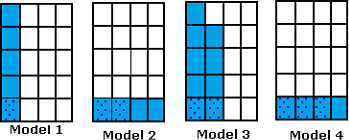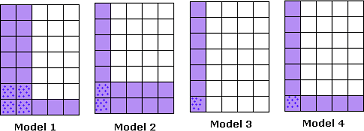Solved Examples and Worksheet for Multiplication of Unit Fractions using Models
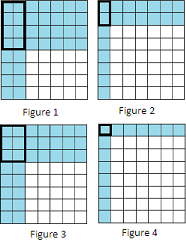
A. Figure 4
B. Figure 3
C. Figure 2
D. Figure 1
Step: 1
We represent 1 whole with a rectangle. Divide it vertically into 7 sections because the denominator of the first fraction is 7.
Step: 2
Again divide the rectangle horizontally into 8 sections because the denominator of the second fraction is 8.
Step: 3
Color any 1 of the vertical sections of the rectangle because the numerator of the first fraction is 1.
Step: 4
Color any 1 of the horizontal sections because the numerator of the second fraction is 1.
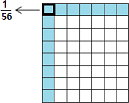

Step: 5
The common area of the rectangle, where both the column and the row overlap is encircled. It represents the required product 1 5 6
Correct Answer is : Figure 4
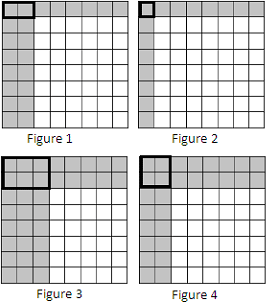
A. Figure 2
B. Figure 1
C. Figure 4
D. Figure 3
Step: 1
We represent 1 whole with a rectangle. Divide it vertically into 8 sections because the denominator of the first fraction is 8.
Step: 2
Again divide the rectangle horizontally into 8 sections because the denominator of the second fraction is 8.
Step: 3
Color any 1 of the vertical sections of the rectangle because the numerator of the first fraction is 1.
Step: 4
Color any 1 of the horizontal sections because the numerator of the second fraction is 1.
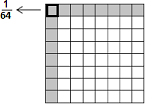

Step: 5
The common area of the rectangle, where both the column and the row overlap is encircled. It represents the required product 1 6 4
Correct Answer is : Figure 2
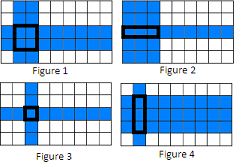
A. Figure 3
B. Figure 1
C. Figure 4
D. Figure 2
Step: 1
We represent 1 whole with a rectangle. Divide it vertically into 9 sections because the denominator of the first fraction is 9.
Step: 2
Again divide the rectangle horizontally into 5 sections because the denominator of the second fraction is 5.
Step: 3
Color any 1 of the vertical sections of the rectangle because the numerator of the first fraction is 1.
Step: 4
Color any 1 of the horizontal sections because the numerator of the second fraction is 1.


Step: 5
The common area of the rectangle, where both the column and the row overlap is encircled. It represents the required product 1 4 5
Correct Answer is : Figure 3
- Interpreting Multiplication as Scaling or Resizing-Gr 5-Solved Examples
- Interpreting Fractions by Division of Whole Numbers-Gr 5-Solved Examples
- Relationship between Fraction and Division-Gr 5-Solved Examples
- Adding and Subtracting Fractions-Unlike Denominators-Gr 5-Solved Examples
- Multiplying Fractions with Whole Numbers-Gr 5-Solved Examples
- Multiplying Fractions with Fractions-Gr 5-Solved Examples
- Dividing Fraction by a Whole Number and vice versa-Gr 5-Solved Examples
- Adding Mixed Numbers-Unlike Denominators-Gr 5-Solved Examples
- Subtracting Mixed Numbers-Unlike Denominators-Gr 5-Solved Examples
- Application of Adding Fractions-Like Denominators-Gr 5-Solved Examples
- Application of Adding Fractions-Unlike Denominators-Gr 5-Solved Examples
- Application of Subtracting Fractions-Like Denominators-Gr 5-Solved Examples
- Application of Subtracting Fractions-Unlike Denominators-Gr 5-Solved Examples
- Application of Multiplying Fractions-Gr 5-Solved Examples
- Estimating Addition and Subtraction of Fractions-Gr 5-Solved Examples
- Equivalent Fraction for a given Fraction-Gr 5-Solved Examples
Related Worksheet
- Product
















